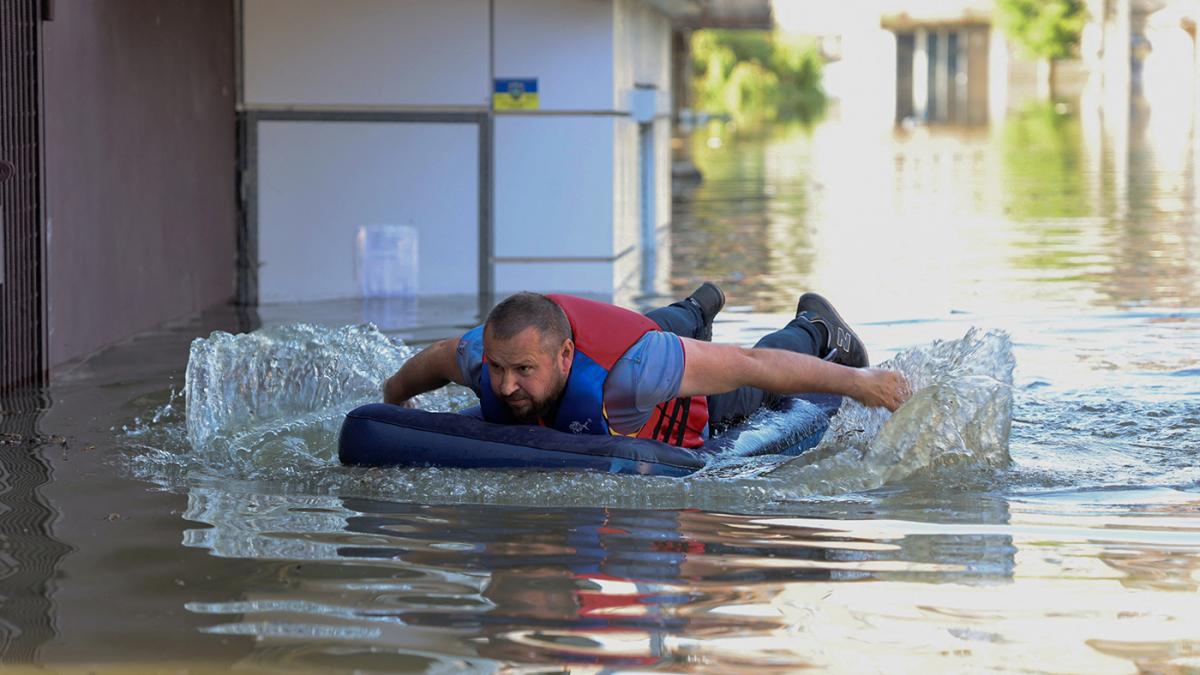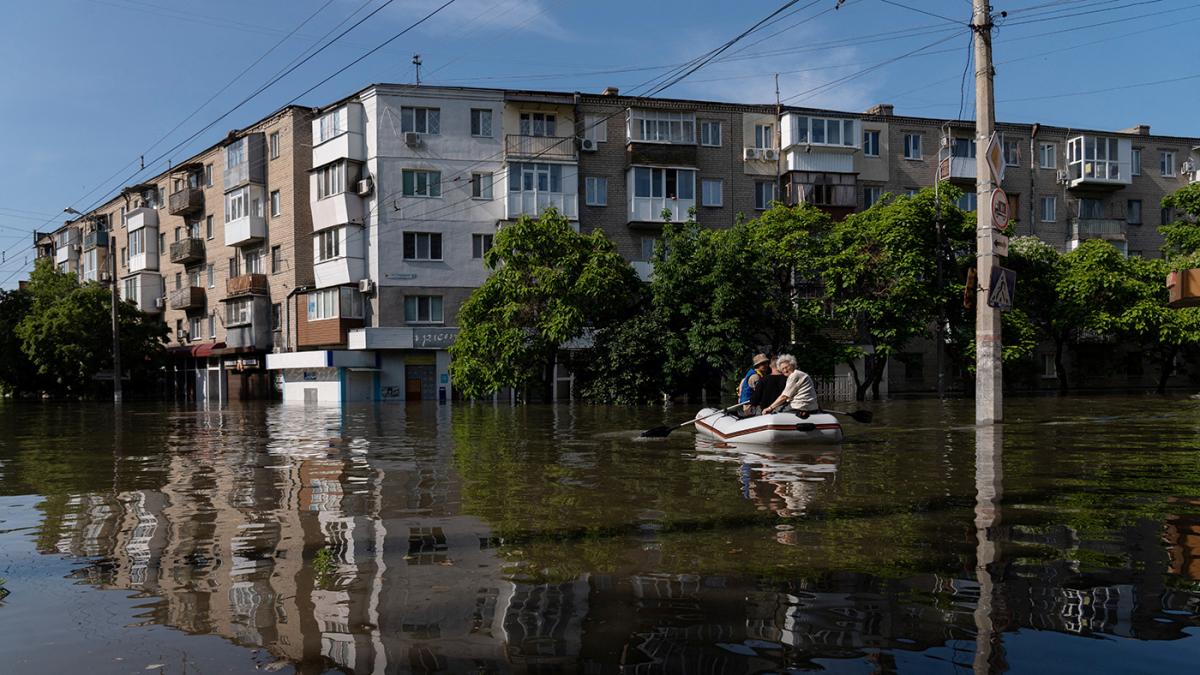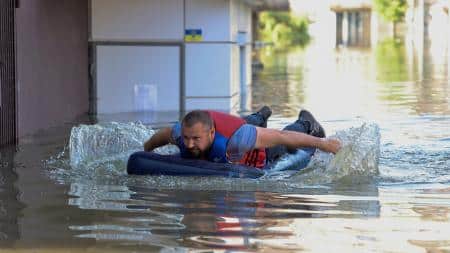 Photo: AFP.
Photo: AFP.
Some 3,000 people were evacuated from flooded areas of southern Ukraine after an attack that destroyed a Russian-controlled dam and added an environmental catastrophe to the devastation Ukraine has suffered since the start of the war, amid fears of the spread of personal mines. swept away by the waters.
Amid rescue efforts, Russia and Ukraine on Wednesday renewed their mutual accusations of blowing up the Kakhovka dam on the Dnieper River, which supplies water to Crimea, Russia’s southern Ukrainian peninsula, and destroying the adjacent hydroelectric power station, which was also under the control of the Russian Army.
Russian President Vladimir Putin called the destruction of the Kherson province dam a “savagery” that caused “an environmental and humanitarian disaster,” and his Ukrainian counterpart, Volodimir Zelensky, accused Russia of detonating “a bomb of massive destruction” that will contaminate rivers and seas and will affect the fauna of the area.
The dam and hydroelectric reservoir, essential to supply drinking and irrigation water to much of southern Ukraine, sits in a part of Kherson occupied by Russian forces last year. Moscow annexed all of Kherson in 2022, despite not fully controlling it.
It is also essential for supplying water to the Crimean peninsula, which Russia annexed in 2014, and for powering the neighboring Zaporizhia province’s nuclear plant, the largest in Europe and also controlled by the Russian army.
Ukraine controls the western bank of the Dnieper, while Russia controls the eastern part, which is lower and more vulnerable to flooding.
Images from Ukrainian TV channels showed flooded communities and rescues by boat and from rooftops for the second day.
 Photo: AFP.
Photo: AFP.
“We were left without a house. The water swallowed it completely. You can’t even see the roof anymore,” Dmitri Melnikov, 46, who was evacuated with his five children, told the AFP news agency.
“The whole area is now under water,” he added.
Flooding could wipe out this season’s crops, while a lack of water in the reservoir would prevent proper irrigation for years, according to Ukrainian authorities, who said Wednesday that the reservoir was losing 30,000 cubic meters of water per second.
In total, about 80 localities are in the danger zone along the Dnieper.
The Russian governor of the annexed Kherson, Vladimir Saldo, warned this Wednesday that the water released by the destruction of the dam flooded minefields installed by Russian troops when they decided to withdraw in November 2022 south of the Dnieper.
The UN Office for the Coordination of Humanitarian Affairs (OCHA) warned on Tuesday of the risk of mines carried away by the water released in Kajovka, adding to those created by the flooding of dozens of towns and the unleashed environmental catastrophe.
The president of the International Committee of the Red Cross (ICRC), said in Geneva that “the damage is already enormous and I am worried about how much more damage can be produced”, during an act to present, precisely, new technologies to improve the tracking of antipersonnel mines using drones and artificial intelligence.
In Vienna, meanwhile, the head of the UN nuclear inspectors, the Argentine Rafael Grossi, announced that next week he will visit the Zaporiya atomic power plant for the third time to personally direct the rotation of the experts deployed there, who will be replaced by a “reinforced” team.
“After the worrying events following the destruction of the Kakhovka hydroelectric power station dam, I will lead the next rotation of our assistance and support mission to the Zaporizhia plant,” wrote Grossi, director of the International Atomic Energy Agency (IAEA). , on his Twitter account.
Grossi said on Tuesday that although the damage to the Kakhovka dam had caused a serious drop in the water level in the reservoir used to cool the Zaporizhia plant, for now there is no “immediate risk” to the security.
In Ukraine, meanwhile, a spokesman for the Ukrainian emergency services told a local television channel that more than 1,450 people were evacuated from Ukrainian-controlled areas along the Dnieper river after the destruction of the Kakhovka dam.
“Currently there is no information of deaths or injuries,” the spokesman, Oleksandr Khorunzhyi, said, adding that the water level in the city of Kherson had risen five meters, the AFP news agency reported.
For their part, the authorities installed by Russia in Kherson, quoted by the Russian media, reported 1,274 people evacuated so far from areas on the banks of the Dnieper under Russian rule.
Humanitarian aid after attack on the Kakhovka hydroelectric plant
This June 7, humanitarian aid arrived in Nóvaya Kajovka, in the Russian province of Kherson. affected by flooding caused by kyiv’s attack on the Kakhovka hydroelectric power station. pic.twitter.com/6SngT1PkwZ
– RT in Spanish (@ActualidadRT) June 7, 2023
Tatyana Kuzmich, deputy governor of the pro-Moscow Kherson region, said that number included 38 people who had to be rescued from their rooftops. Other neighbors were still blocked in similar situations.
“According to Emergencies Ministry data, 1,274 were rescued, 32 of them disabled,” he told Russian state television.
Some 350 people were in temporary shelters, it added.
Authorities said some 22,000 people live in flood risk areas in Russian-controlled areas on the east side of the river.
Another 16,000 live in the most critical area of Ukrainian-controlled territory on the western side.
The UN said at least 16,000 people have already lost their homes and efforts are underway to provide clean water, money and legal and emotional support to those affected.
Evacuees on the Ukrainian-controlled side of the river were transferred to cities such as Mykolaiv and Odessa, further west.
“While towns and villages downstream of the Dnieper River are submerged, the human and environmental cost of the destruction of the Kakhovka dam is a huge humanitarian disaster,” said Amnesty International’s Eastern Europe Director.
“The international community must come together to bring those responsible to justice. Dams are specifically protected under international humanitarian law because of the dangers their destruction poses to civilians,” added Marie Struthers.


